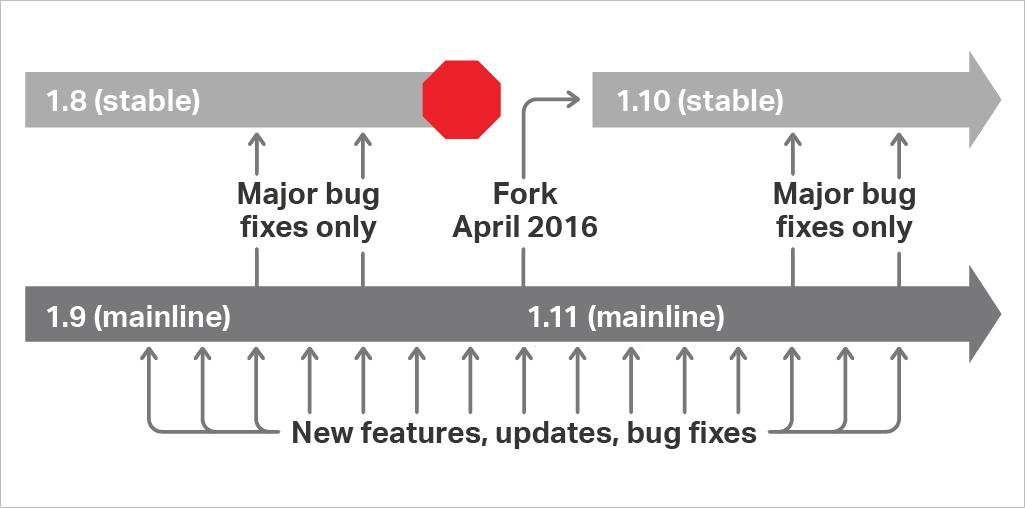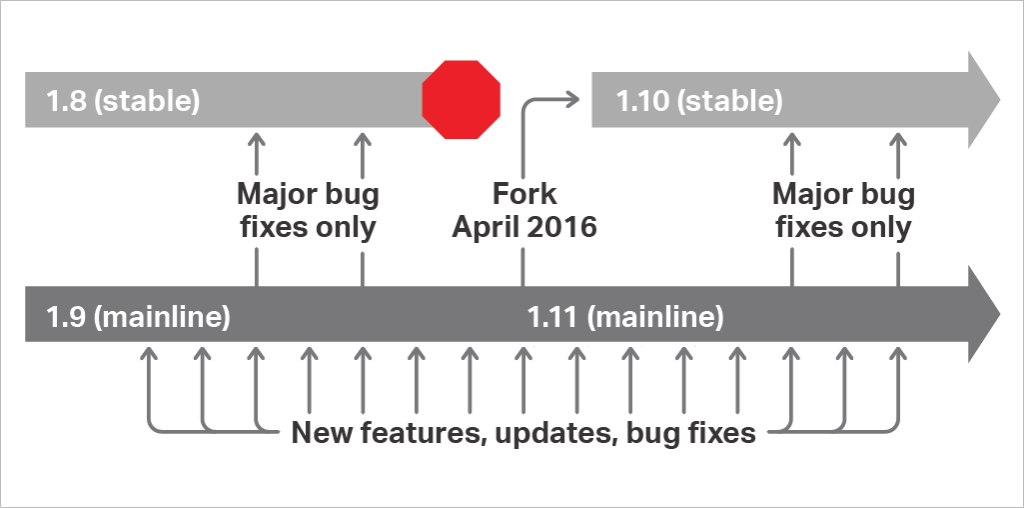Introducing NGINX 1.10 and 1.11

Today we’re pleased to announce NGINX 1.10 and 1.11. These version numbers define our stable and mainline branches – the open source releases that we will focus on developing and improving for the next 12 months.
NGINX version 1.10.0 was released today, and the next feature release of our mainline branch will be numbered 1.11.0.
Explaining NGINX’s Version Numbering
NGINX, Inc. manages two branches of the well-known open source NGINX web server and accelerating proxy:
- The odd-numbered version (1.11) is the mainline branch. This branch is actively developed; new minor releases (1.11.1, 1.11.2, etc.) are made approximately every 4 to 6 weeks, regularly introducing new features.
- The even-numbered version (1.10) is our stable branch. This branch is provided for users who don’t want to stay at the forefront of NGINX development, and is updated only when critical issues need to be fixed. For example, last year only one minor release was made to the 1.8 stable branch.
Each year, we deprecate the current stable branch and fork the current mainline branch to create a new stable branch that is supported for the following 12 months:
Choose the branch that best suits your needs. If you want to stay on top of new features, performance improvements, and updates, select the mainline branch, which (ironically) is generally more reliable than the stable branch. If you want to minimize the number of updates you need to deploy and don’t anticipate an urgent need for any of the features planned for the next 12 months, the stable branch is a good choice.
A best-of-both-worlds option is NGINX Plus, with its quarterly release schedule, rigorous testing, and support from the NGINX team. NGINX Plus tracks the mainline branch, and benefits from in-the-field testing and user feedback on mainline branch features.
Looking Back on NGINX 1.9
Last year was one of the busiest years for development in NGINX’s history. It saw a number of new features and capabilities added to our mainline branch. HTTP/2, TCP and UDP proxying and load balancing, and dynamic modules were all added to the open source release in the last 12 months.
NGINX mainline also saw numerous other feature improvements, bug fixes, and other enhancements – check out the release notes for a full list of changes in 1.9 – making this series of releases the most extensive development of NGINX in its recent history. The small number of changes that needed to be backported to the 1.8 stable release is a clear testament to the high standards of quality and reliability that our engineering team maintains.
We also hit a major milestone in NGINX adoption in 2015. Although we don’t set out to compete or take market share from other web servers, it’s gratifying to see a continued steady growth in the use of NGINX, and now more than 50% of the world’s 10,000 busiest websites rely on NGINX to deliver their applications and content to their audience.
Looking Forward to NGINX 1.11
The NGINX 1.11 release series also promises to bring significant advances. Work is already ongoing with a prototype JavaScript implementation, nginScript, specifically designed for the unique demands of the NGINX core. We’re going to continue to foster an NGINX developer community, building on the milestone dynamic modules feature and the first part of the recently published developer documentation. The demands of modern, distributed, microservices applications are also driving part of our roadmap, and more will be shared at our annual user conference, nginx.conf, in September 2016.
What about NGINX Plus?
NGINX Plus is our commercially supported product, and adds a number of enhanced features that extend NGINX into the role of a frontend load balancer and application delivery controller (ADC). NGINX Plus tracks the mainline branch of NGINX and is generally released on a three-month cycle. New features in the mainline branch are merged into NGINX Plus and released after they have passed full integration testing and have been proven in field deployments of NGINX:
Each NGINX Plus release corresponds to a numbered build of the open source mainline branch, as noted at NGINX Plus Releases. To display the version number for a running NGINX or NGINX Plus instance, run the nginx -v command:
$ nginx -v
nginx version: nginx/1.9.13 (nginx-plus-r9)NGINX Plus gives you an ideal balance of the cutting-edge features in open source NGINX, proven in the field, additional load-balancing and enterprise-focused features, and full 24×7 support and updates from our engineering team and product experts. Try it out for yourself – start your free 30-day trial today or contact us for a live demo.
The post Introducing NGINX 1.10 and 1.11 appeared first on NGINX.
Source: Introducing NGINX 1.10 and 1.11
